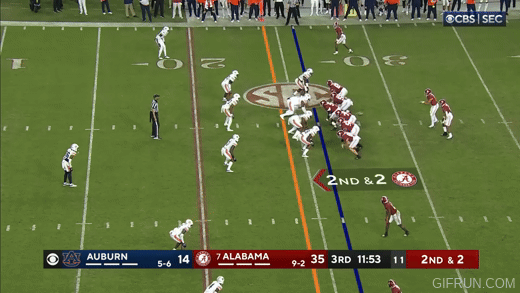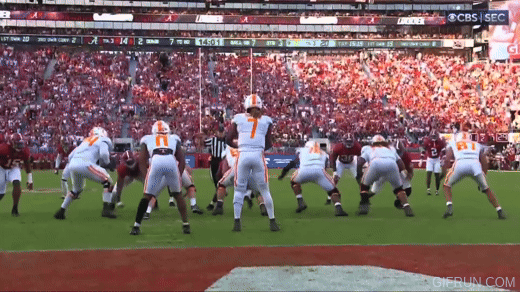The Athletic has live coverage of Alabama vs. LSU in Week 10 of college football action
One of Alabama’s biggest question marks entering this season is still taking shape and is now due for evaluation at the bye week. The program replaced both offensive and defensive coordinators for the fifth time in Nick Saban’s tenure, with the hires on opposite ends of the spectrum — the 30-plus-year veteran Kevin Steele (defense) and the 31-year-old Tommy Rees (offense).
The team sits at 7-1 overall, 5-0 in the SEC and squarely in the College Football Playoff debate. Through eight weeks, from a statistical standpoint, here’s how Alabama compares from 2022 to 2023:
| 2022 | 2023 | |
|---|---|---|
Total offense | 477.2 ypg (11th) | 366.6 ypg (81st) |
Yards per play | 6.9 ypp (8th) | 5.9 ypp (58th) |
Scoring | 41.1 ppg (T-4th) | 30.6 ppg (49th) |
Passing | 281.5 ypg (19th) | 219.5 ypg (79th) |
Yards per attempt | 8.4 ypa (18th) | 9.6 ypa (7th) |
Rushing | 195.0 ypg (30th) | 147.1 ypg (78th) |
Rushing per carry | 5.6 ypc (4th) | 3.7 ypc (98th) |
3rd down | 45.7% (23rd) | 43.4% (T-39th) |
| 2022 | 2023 | |
|---|---|---|
Total defense | 318.2 ypg (13th) | 306.4 ypg (15th) |
Yards per play | 4.6 ypp (4th) | 4.6 ypp (13th) |
Scoring | 18.2 ppg (T-9th) | 16.5 ppg (15th) |
Passing | 187.8 ypg (17th) | 197.6 ypg (30th) |
Yards per attempt | 5.6 ypa (3rd) | 6.2 ypa (T-19th) |
Rushing | 130.4 ypg (35th) | 108.8 ypg (23rd) |
Rushing per carry | 3.6 ypc (30th) | 3.1 ypc (19th) |
3rd down | 30.3% (10th) | 34.5% (37th) |
Offense
The obvious difference, and the No. 1 question about Alabama entering 2023, was how would Bryce Young be replaced. The Alabama offense is now settled in with Jalen Milroe, and there’s clearly a different identity through eight weeks.
Under former coordinator Bill O’Brien, the offense dropped back to pass nearly 57 percent of the time, according to TruMedia. Last season’s rush offense with Jahmyr Gibbs averaged 195 yards per game, despite Gibbs ranking 83rd nationally with 151 carries. Naturally with that run-pass split and Alabama’s reputation for superior wide receiver play, the offense lined up in 11 personnel (one running back, one tight end and three wide receivers) over 70 percent of the time in 2021 and 2022 combined.
Advertisement
This year’s Alabama offense is the inverse, dropping back to pass 48 percent of the time and, if you factor in dropbacks that turn into rushes, running the ball 57 percent of the time. Schematically, the biggest change is Rees’ usage of 12 personnel (one running back, two tight end and two wide receivers). Alabama has two tight ends on the field 43 percent of the time compared to just 9 percent last season. Tight ends CJ Dippre, Amari Niblack and Robbie Ouzts see about 30-35 plays per game each while only two receivers — Jermaine Burton and Isaiah Bond — have played more than 50 percent of the total offensive snaps. Fewer receivers are playing consistent snaps, but Alabama has curtailed last season’s drop issue — drops are down to 5.1 percent, less than the national average and less than half of last season’s 10.8 percent.
Within the passing game, the plan of attack for the respective QB/coordinator duos is also different. A staple of O’Brien’s offense with Young was the run-pass option: 62 percent of Young’s throws in 2022 traveled fewer than 10 yards in the air (or were behind the line of scrimmage). Plays like these were a mainstay:

Conversely, Milroe’s attempts in that range are almost 8 percent lower — nearly 45 percent of his passes travel 11-plus yards in the air. Rees has flashed short, timing routes and RPOs recently, with one of the notable plays in the Tennessee game being the short crosser to Bond that set up the first touchdown. But longer completions have been Milroe’s strength. Through eight weeks, he’s completed 58 percent of passes traveling 21-plus yards in the air; 12 of his 13 touchdown passes are longer than 10 yards.
Another element that might not be as noticeable is running back usage in the passing game. Gibbs was a great pass catcher and led the team in receptions last season, and Jase McClellan is a proven commodity with six touchdown receptions in 2021-22. However, this year Alabama running backs have 96 receiving yards combined and zero touchdowns.
Advertisement
Like last season, Alabama is mainly employing a pair of running backs, with this year’s duo of McClellan and Roydell Williams handling most of the workload.
Another area that’s similar — and similarly disappointing — this season is the offensive line. This year’s group has allowed pressure on 37.3 percent of dropbacks, which ranks 112th nationally; last year: 32.6 percent, 72nd nationally. O’Brien and Rees both favor inside zone rushes between the tackles, but the Tide have executed that with varying degrees of success. Last season, Alabama averaged 5.6 yards per carry in that area; this year it’s down to 4.6 yards per carry.
One constant is running behind JC Latham at right tackle, with runs to his side in 2022 and 2023 averaging over seven yards per carry. This run by Williams against Tennessee, where Latham (with the help of Jaeden Roberts) seals off his side, illustrates why:

It’s been an adjustment for Rees with his new personnel, but there have been signs of optimism in recent weeks. He’s done well with scheming players open on big plays, with Bond and Kobe Prentice being beneficiaries over the last few weeks. He’s also flashed some creative looks with certain players, one example being Kendrick Law.
Law, listed at 5-feet-11 and 201 pounds, is known for his aggressive play style. In the first game of the season, Rees used Law in a two-tight end look where he masqueraded as a third tight end to spring a run loose for a good gain. This play has RPO potential in a different look:

Law’s gotten healthier of late and logged 22 offensive snaps last week. Rees used him again for a good gain, this time in a pop pass/jet sweep to get his physical frame going downhill:

It’ll be interesting to see how Rees’ offense will look coming out of the bye, but using the last few weeks for reference, I expect a little more variance.
Defense
Steele’s adjustment has been far less drastic in his third stint on Alabama’s staff. During preseason camp, Steele estimated that about 80 percent of the verbiage was the same upon his return, and the changes in his defense compared to Pete Golding’s are less about scheme and more about play style.
Advertisement
The defense’s biggest questions entering 2023 were more centered on fundamentals: Could this defense improve its tackling, cut down on penalties and limit communication errors that led to explosive plays? Through eight weeks, those questions have been answered with a definitive yes.
Per Pro Football Focus, Alabama’s 2022 defense missed 108 tackles, the first 100-plus missed tackle season for the Tide in the PFF era (since 2014). This year’s group is improved, with the defense allowing 2.4 rushing yards after contact, which ranks 15th nationally, as compared to 31st in 2022.
Credit Steele and new position coach Robert Bala for their work with the inside linebackers this season. The trio of Deontae Lawson, Trezmen Marshall and Jihaad Campbell are filling their run gaps with much more consistency, and when there’s an opening, they are rarely half-stepping. This group is playing with speed and aggressiveness.

Below is an example of the secondary’s commitment to better communication: on a third-and-17 in the third quarter against Tennessee, Kool-Aid McKinstry notices something is off and goes above and beyond to get the right call to Malachi Moore, one of the best communicators on the team. McKinstry relays the message to Moore and the coverage is sound. Tennessee quarterback Joe Milton has nowhere to go and dumps the ball off in the flat, where the receiver is tackled short of the first down.

Schematically, there has been one stark contrast between Steele and Golding: nickel vs dime. Under Golding, Alabama’s defense lined up in the dime package (six defensive backs) close to 30 percent of the time on average from 2019 through 2022. Through eight weeks this season, Alabama’s lined up in dime coverage only 60 times, or 11 percent of the time, according to TruMedia
The overwhelming majority of snaps (86 percent) are in nickel (five defensive backs), which is the de-facto base defense you see snap-to-snap. This defense isn’t as deep as years past, but the frontline starters are at an elite level. Steele is calling blitzes at a slightly increased rate in 2023 (24 percent) compared to 2022 (22 percent), and Alabama’s sack rate (9.9 percent) is the second-highest mark since 2019, largely due to Dallas Turner and Chris Braswell emerging as one of, if not the, best pass rushing duo in college football.
But Steele’s biggest contribution is his ability to adjust. Alabama has had one of the best second-half defenses in the country, allowing just seven points per second half — almost a three-point improvement compared to 2022. The Tennessee game is the latest example. Alabama held the Volunteers scoreless after a 20-point first half; last season, Hendon Hooker and the Vols scored 24 points in the second half in their win over Alabama. There are some schematics involved with halftime adjustments, but the players are pointing just as strongly to a shift in mentality.
Advertisement
“Our strive and our goal is to be a 60-minute, complete team,” defensive lineman Justin Eboigbe said. “If you walk around the facility, you see “fourth quarter” is our motto. It’s something we live by. We always try to push it to another gear. We feel like teams can’t compete with us for a full 60 minutes and that games aren’t just won in the first half or in the first or second quarter or the third quarter. It’s won in the full 60 minutes, and that’s how we look at it. We’re able to make readjustments, not just team-wise but just individuals.”
When proper adjustments meet sound communication and execution, good things happen defensively. This is evident in the big strip sack touchdown against Tennessee last week. This stacked-wide receiver look by the Volunteers had given Alabama trouble dating back to 2022. However, on this play, Alabama’s defensive back triangle of Trey Amos, Jaylen Key and Moore played it perfectly. Amos presses his man, and Moore, who falls out of the frame, makes a good break on the outside receiver with Key supporting inside. With nowhere to go, Milton holds the ball a little too long and Braswell comes from behind with the game-changing sack.

(Photo of Kendrick Law: John David Mercer / USA Today)

